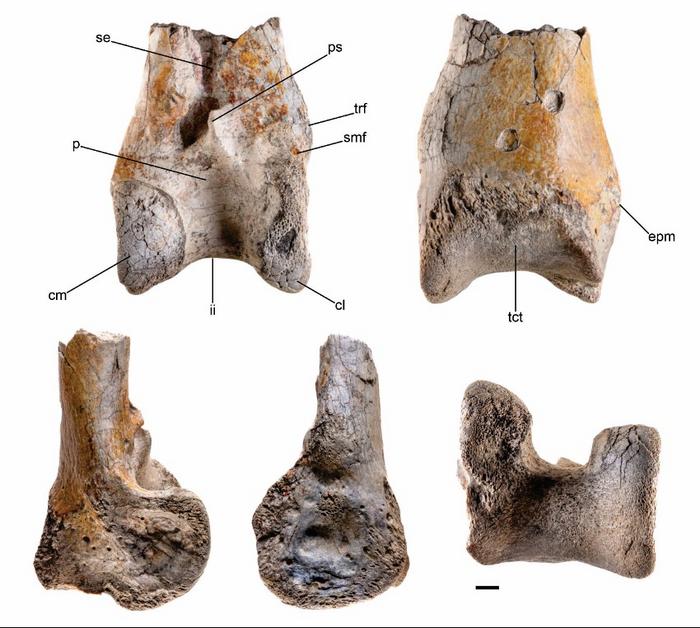A newly discovered leg bone from Columbia is likely to be from the largest member of the Phorusrhacid family – appropriately known as “terror birds” – we have yet found, and could have stood more than 3 meters tall. The team describing the fossil thinks the individual it came from was 5-20 percent larger than the previous record-holder.
Now that we know birds are dinosaurs, it is not surprising that a few reclaimed some of their former stature in the post-Cretaceous age. The most formidable birds of the Cenozoic have usually been on islands, like Madagascar’s elephant birds or New Zealand’s moa, where they faced less competition from mammals.
The Phorusrhacids, on the other hand, fully earned their nicknames as “terror birds”. Not only were they meat eaters, rather than living on fruit or seeds like most giant birds, but they were apex predators for at least 43 million years in South America where big mammals were abundant. They probably filled the same niche in Antarctica before it became icebound.
The bone that expands terror birds’ size range is not new, having been found almost 20 years ago. However, when Cesar Perdomo of the Museo La Tormenta in Colombia found the fossil, he was not sure what it was. Now researchers have made a 3D model of the bone and concluded it came from a member of the Phorusrhacids.
“Terror birds lived on the ground, had limbs adapted for running, and mostly ate other animals,” explained co-author Dr Siobhan Cooke of Johns Hopkins University in a statement. Size calculations based on part of one bone are necessarily rough, but Cooke and co-authors estimate it would have weighed 156 kg (343 pounds). With relatives equipped with smaller footbones having approached 3 meters (10 feet) tall, this one may well have exceeded that height.

It’s only a part of a left tibiotarsus, but it indicates its owner was a terror bird larger than any found before.
Image credit: Degrange et al., 2024, Palaeontology
The fossil is from the Miocene, 12 million years ago, and is from the lower left leg, equivalent to a human shin. Its size made paleontologists doubt its origins, but scans reveal deep pits, a distinctive feature of Phorusharcids’ leg bones. In addition to the natural pits, the scans also revealed teeth marks, probably from a member of the crocodilian order.
Cooke and co-authors of a paper describing the find think the bite came from a Purussaurus. Despite the ending of its name, Purussaurus was not a dinosaur, but it was just as terrifying: a 9-meter (30-foot) long caiman.
“We suspect that the terror bird would have died as a result of its injuries given the size of crocodilians 12 million years ago,” Cooke said.
Besides its size and suspected cause of death, the discovery is remarkable for another reason. Most terror bird fossils have been found in Argentina and its surroundings. The Tatacoa Desert in Colombia, where this find was made, is north of the equator. Its dry canyons have been a rich source of fossils for more than a hundred years, but Phorusharcids have not been found there before.
The authors consider this a sign Phorusharcids were not that common in what is now the Tatacoa, which was a rich river province at the time this particular individual lived. On the other hand, Cooke acknowledged, “It’s possible there are fossils in existing collections that haven’t been recognized yet as terror birds because the bones are less diagnostic than the lower leg bone we found.”
Terror birds or not, the region at the time would have been a wildlife documentary maker’s dream. “It’s a different kind of ecosystem than we see today or in other parts of the world during a period before South and North America were connected,” Cooke said. Examples include glyptodonts (relatives of armadillos the size of cars), giant ground sloths, hoofed animals filling the niches of zebra or impala in Africa, and even monkeys whose ancestors had made the epic raft journey.
Although Phorusharcid fossils were much more common in the southern half of South America, finding one so far north is not a complete surprise. When Panama connected to South America, allowing species to interchange between the two continents, the northerners had the better of it. As far as we know, terror birds were the only large predators from South America to make use of the connection, subsequently being found in places like Texas. They appear to have made the crossing around 5 million years ago and must have been in the region before that time. Nevertheless, previously none of the family had been found in South America north of southern Peru, more than 2,000 kilometers (1,243 miles) away.
The study is open access in Paleontology.
Source Link: 12 Million-Year-Old Fossil Reveals What May Be The Largest Terror Bird To Have Ever Lived